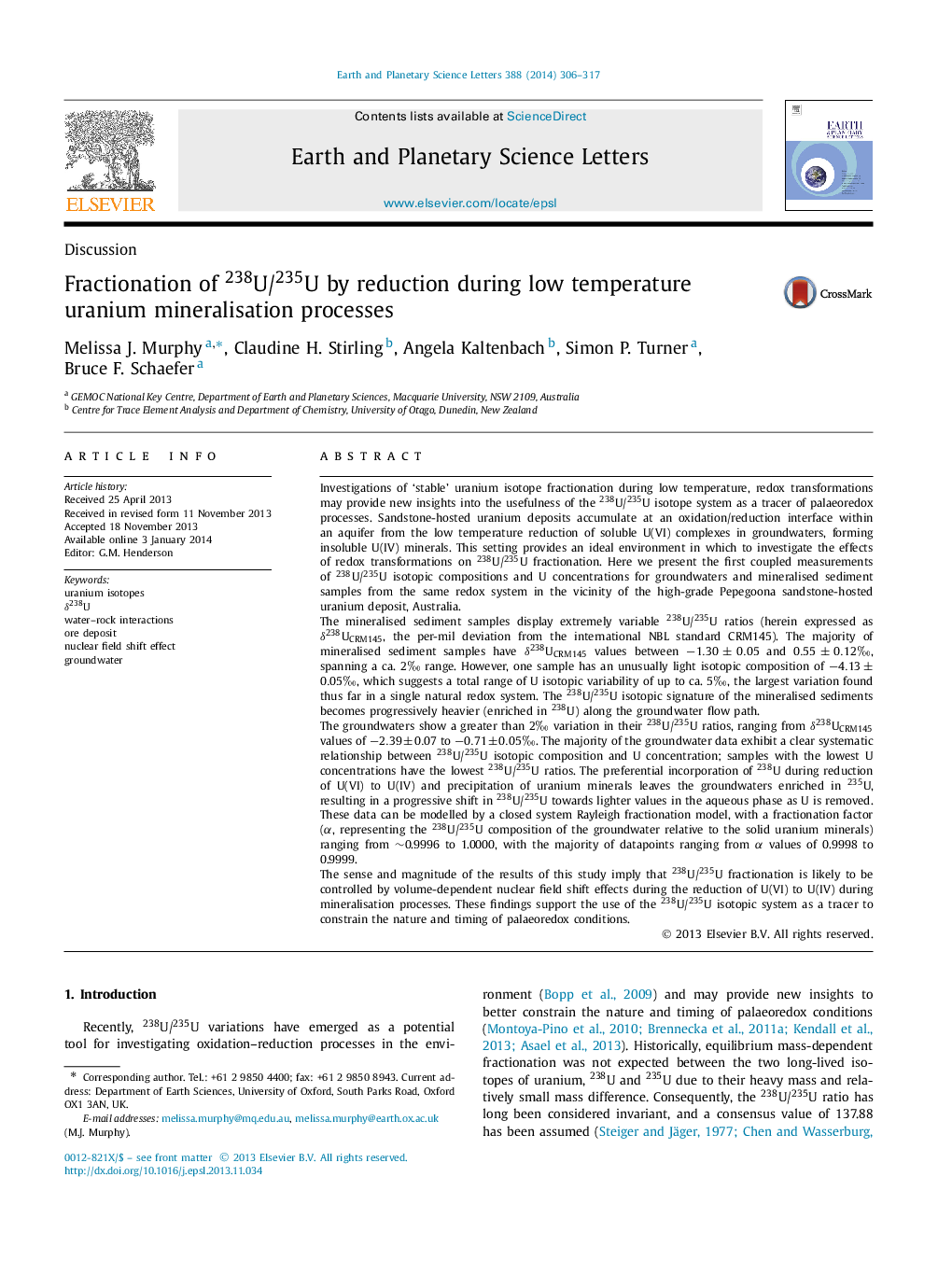| کد مقاله | کد نشریه | سال انتشار | مقاله انگلیسی | نسخه تمام متن |
|---|---|---|---|---|
| 6429816 | 1634768 | 2014 | 12 صفحه PDF | دانلود رایگان |

- δU238 presented for groundwaters and sediments from a low-T redox uranium deposit.
- Groundwater δU238 values decrease systematically with U(VI) reduction.
- Groundwater δU238 explained by kinetic Rayleigh fractionation (α=0.9996-1.0000).
- Fractionation reflects nuclear field shift effects during U(VI) reduction to U(IV).
- Useful as a tracer for oxidation/reduction in modern and palaeoredox environments.
Investigations of 'stable' uranium isotope fractionation during low temperature, redox transformations may provide new insights into the usefulness of the 238U/235U isotope system as a tracer of palaeoredox processes. Sandstone-hosted uranium deposits accumulate at an oxidation/reduction interface within an aquifer from the low temperature reduction of soluble U(VI) complexes in groundwaters, forming insoluble U(IV) minerals. This setting provides an ideal environment in which to investigate the effects of redox transformations on 238U/235U fractionation. Here we present the first coupled measurements of 238U/235U isotopic compositions and U concentrations for groundwaters and mineralised sediment samples from the same redox system in the vicinity of the high-grade Pepegoona sandstone-hosted uranium deposit, Australia.The mineralised sediment samples display extremely variable 238U/235U ratios (herein expressed as δUCRM145238, the per-mil deviation from the international NBL standard CRM145). The majority of mineralised sediment samples have δUCRM145238 values between â1.30±0.05 and 0.55±0.12â°, spanning a ca. 2â° range. However, one sample has an unusually light isotopic composition of â4.13±0.05â°, which suggests a total range of U isotopic variability of up to ca. 5â°, the largest variation found thus far in a single natural redox system. The 238U/235U isotopic signature of the mineralised sediments becomes progressively heavier (enriched in 238U) along the groundwater flow path.The groundwaters show a greater than 2â° variation in their 238U/235U ratios, ranging from δUCRM145238 values of â2.39±0.07 to â0.71±0.05â°. The majority of the groundwater data exhibit a clear systematic relationship between 238U/235U isotopic composition and U concentration; samples with the lowest U concentrations have the lowest 238U/235U ratios. The preferential incorporation of 238U during reduction of U(VI) to U(IV) and precipitation of uranium minerals leaves the groundwaters enriched in 235U, resulting in a progressive shift in 238U/235U towards lighter values in the aqueous phase as U is removed. These data can be modelled by a closed system Rayleigh fractionation model, with a fractionation factor (α, representing the 238U/235U composition of the groundwater relative to the solid uranium minerals) ranging from â¼0.9996 to 1.0000, with the majority of datapoints ranging from α values of 0.9998 to 0.9999.The sense and magnitude of the results of this study imply that 238U/235U fractionation is likely to be controlled by volume-dependent nuclear field shift effects during the reduction of U(VI) to U(IV) during mineralisation processes. These findings support the use of the 238U/235U isotopic system as a tracer to constrain the nature and timing of palaeoredox conditions.
Journal: Earth and Planetary Science Letters - Volume 388, 15 February 2014, Pages 306-317